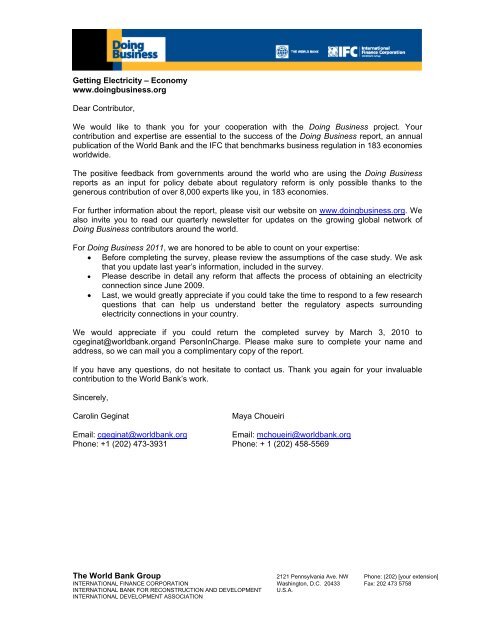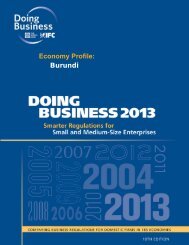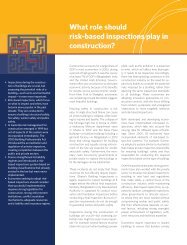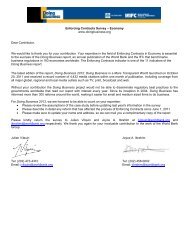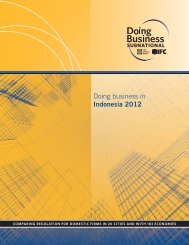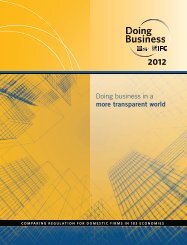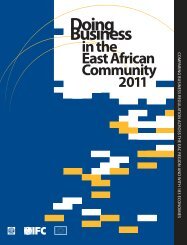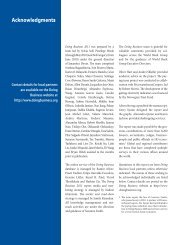The World Bank Group Getting Electricity ... - Doing Business
The World Bank Group Getting Electricity ... - Doing Business
The World Bank Group Getting Electricity ... - Doing Business
You also want an ePaper? Increase the reach of your titles
YUMPU automatically turns print PDFs into web optimized ePapers that Google loves.
<strong>Getting</strong> <strong>Electricity</strong> – Economy<br />
www.doingbusiness.org<br />
Dear Contributor,<br />
We would like to thank you for your cooperation with the <strong>Doing</strong> <strong>Business</strong> project. Your<br />
contribution and expertise are essential to the success of the <strong>Doing</strong> <strong>Business</strong> report, an annual<br />
publication of the <strong>World</strong> <strong>Bank</strong> and the IFC that benchmarks business regulation in 183 economies<br />
worldwide.<br />
<strong>The</strong> positive feedback from governments around the world who are using the <strong>Doing</strong> <strong>Business</strong><br />
reports as an input for policy debate about regulatory reform is only possible thanks to the<br />
generous contribution of over 8,000 experts like you, in 183 economies.<br />
For further information about the report, please visit our website on www.doingbusiness.org. We<br />
also invite you to read our quarterly newsletter for updates on the growing global network of<br />
<strong>Doing</strong> <strong>Business</strong> contributors around the world.<br />
For <strong>Doing</strong> <strong>Business</strong> 2011, we are honored to be able to count on your expertise:<br />
Before completing the survey, please review the assumptions of the case study. We ask<br />
that you update last year’s information, included in the survey.<br />
Please describe in detail any reform that affects the process of obtaining an electricity<br />
connection since June 2009.<br />
Last, we would greatly appreciate if you could take the time to respond to a few research<br />
questions that can help us understand better the regulatory aspects surrounding<br />
electricity connections in your country.<br />
We would appreciate if you could return the completed survey by March 3, 2010 to<br />
cgeginat@worldbank.organd PersonInCharge. Please make sure to complete your name and<br />
address, so we can mail you a complimentary copy of the report.<br />
If you have any questions, do not hesitate to contact us. Thank you again for your invaluable<br />
contribution to the <strong>World</strong> <strong>Bank</strong>’s work.<br />
Sincerely,<br />
Carolin Geginat<br />
Email: cgeginat@worldbank.org<br />
Phone: +1 (202) 473-3931<br />
Maya Choueiri<br />
Email: mchoueiri@worldbank.org<br />
Phone: + 1 (202) 458-5569<br />
<strong>The</strong> <strong>World</strong> <strong>Bank</strong> <strong>Group</strong> 2121 Pennsylvania Ave. NW Phone: (202) [your extension]<br />
INTERNATIONAL FINANCE CORPORATION Washington, D.C. 20433 Fax: 202 473 5758<br />
INTERNATIONAL BANK FOR RECONSTRUCTION AND DEVELOPMENT U.S.A.<br />
INTERNATIONAL DEVELOPMENT ASSOCIATION
Primary Contributor Information<br />
All information will be published. Please check the information you do not want us to publish.<br />
We do not publish mobile phone numbers.<br />
Do not<br />
publish<br />
Not<br />
published<br />
Not<br />
published<br />
Do not<br />
publish<br />
Not<br />
Published<br />
Name<br />
Update<br />
Title (Mr., Ms., Mrs., etc.) [ ]<br />
First Name<br />
[ ]<br />
Last Name<br />
[ ]<br />
Position (e.g. manager,<br />
associate, partner)<br />
Profession (e.g. judge,<br />
lawyer, architect)<br />
Contact details<br />
[ ]<br />
[ ]<br />
Firm name [ ]<br />
E-Mail address [ ]<br />
Phone [ ]<br />
Fax [ ]<br />
Website [ ]<br />
Mobile phone [ ]<br />
Do not publish Firm Address<br />
Street [ ] P.O. Box [ ]<br />
City [ ] State/<br />
Province<br />
[ ]<br />
Zip/Postal code [ ] Country [ ]<br />
Please indicate below information of additional contributors who helped with the survey.<br />
Name Occupation Email Phone<br />
[title]<br />
[first name]<br />
[last name]<br />
[firm]<br />
[position]<br />
[profession]<br />
[ ] [phone]<br />
[mobile]<br />
Address, if different<br />
than above<br />
[street]<br />
[state/province]<br />
[city/country]<br />
Page 2 of 14
Case Study Assumptions<br />
<strong>The</strong><br />
warehouse:<br />
<strong>The</strong> power<br />
connection:<br />
Is owned by a local entrepreneur.<br />
Is located in DB City.<br />
Has chosen a location within the official limits of the city where other<br />
warehouses locate (non-residential area).<br />
Is not located in a special economic or investment zone, i.e. the electricity<br />
connection is not subject to subsidization or a faster service under a special<br />
investment promotion regime.<br />
If several options are available in terms of location, we assume that our<br />
warehouse chooses the location where electricity is most easily available.<br />
Has road access. Works involve road crossing (excavation, overhead<br />
lines, etc.), but they are all carried out in a public land, i.e. there is no<br />
crossing into other people's private property.<br />
<strong>The</strong>re are no physical constraints in the area where the property is located.<br />
For e.g. the warehouse is not near a railway.<br />
Is used for storage of refrigerated goods.<br />
Is a new construction (i.e., there was no previous construction on the piece<br />
of land where it is located). It is being connected to electricity for the first<br />
time.<br />
Has 2 stories, both above ground, with a total surface of approximately<br />
1,300.6 m 2 (14,000 ft 2 ). <strong>The</strong> plot of land on which it is built is 929 m 2 (10,000<br />
ft 2 ).<br />
Is a permanent connection.<br />
3-phase, 4-wire Y, 140 kVA (subscribed capacity) (Note: For example, for<br />
countries where the voltage is 120/208 V, this means the current would be<br />
around 400 Ampere. For a voltage of 220/380 V, the current would be<br />
almost 200 Ampere).<br />
Maximum demand is 128 kW.<br />
Low-voltage (LV) connection is 150 meters long (unless a distribution<br />
transformer is installed on the client’s property, in which case LV connection<br />
length=0). We assume either overhead or underground connection,<br />
whatever is more common in the country, and the area in question.<br />
<strong>The</strong> length of any connection (or part thereof) in the customer’s private<br />
domain is negligible.<br />
Connection involves installation of only one electricity meter.<br />
<strong>The</strong> monthly electricity consumption would be 0.07GWh (Gigawatt-hour).<br />
<strong>The</strong> internal wiring is already done until, and including, the customer’s<br />
service panel/ switchboard and the meter base (in the cases where the<br />
meter is connected to the LV side and is located inside or right outside the<br />
customer’s warehouse).<br />
Page 3 of 14
Data Update<br />
For your convenience, last year’s answers are included in this survey. <strong>The</strong>y represent a unified<br />
answer, based on the answers we received from various contributors.<br />
Please update the data, taking into account the assumptions of the case study.<br />
Time is measured in calendar days.<br />
A procedure is an interaction of the client or their representatives (e.g. electrician, hired<br />
electrical contractor/firm) with external parties, including the utility, government agencies,<br />
inspectors, and notaries.<br />
Costs are those for the external connection works only and exclude VAT. Costs such<br />
as for the internal wiring of the warehouse (until and including the panel/switchboard) are<br />
not recorded. In all cases the cost excludes bribes.<br />
External works are those conducted between the utility’s network and the warehouse<br />
entry. Works involving wiring the inside of the warehouse until, and including, the<br />
customer’s panel/switchboard and the meter base (where applicable), are considered the<br />
customer’s responsibility and are not recorded.<br />
1. Please confirm the following:<br />
a. <strong>The</strong> most likely location of the warehouse based on the assumptions above is Area<br />
Collected.<br />
Yes or No, please explain. [ ]<br />
b. Utility Name is a distributor of electricity in Area Collected.<br />
Yes or No, please explain. [ ]<br />
c. If several distribution utilities provide connections in Area Collected, is it accurate to say<br />
that Utility Name serves the majority of customers in the area?<br />
Yes or No, please explain. [ ]<br />
Page 4 of 14
d. In the area assumed in question a. the most likely way (in more than 50% of the cases) to<br />
connect the warehouse to the utility’s network is recorded in the table below as of last<br />
year. Please confirm or update the information, and indicate if it is a correction (i.e.<br />
incorrect data) or a reform (i.e. modification in practice or by law since June 2009).<br />
Type of works<br />
Extension<br />
Last year’s answer Check a box below to<br />
indicate this year's<br />
answer (in case this<br />
represents a change to<br />
last year, please explain)<br />
1 of network<br />
(overhead)<br />
Extension<br />
Please explain. [ ]<br />
1 of network<br />
(underground)<br />
Expansion<br />
Please explain. [ ]<br />
2 of network<br />
(overhead)<br />
Expansion<br />
Please explain. [ ]<br />
2 of network<br />
(underground)<br />
Extension<br />
Please explain. [ ]<br />
1 of network (service is<br />
unclear). Please indicate if it is<br />
overhead or underground.<br />
Expansion<br />
Please explain. [ ]<br />
2 of network (service<br />
is unclear). Please indicate if it is<br />
overhead or underground.<br />
<strong>The</strong> two possibilities (extension<br />
Please explain. [ ]<br />
1<br />
and expansion 2 ) are equally<br />
likely. Please indicate if the<br />
service is overhead or<br />
underground.<br />
Please explain. [ ]<br />
Note:<br />
1. Extension of network is defined as the direct connection of the warehouse to the<br />
low-voltage distribution network by extending overhead wires (if overhead service) or<br />
underground cables (if underground service) to the closest existing point of supply on<br />
that low-voltage network (for example, pole-mounted or pad-mounted distribution<br />
transformer).<br />
2. Expansion of network is defined as the connection of the warehouse to the<br />
medium-voltage distribution network by installing a unit substation (overhead post<br />
including a pole-mounted transformer and its accessories if overhead service;<br />
transformer post including a pad-mounted transformer if underground service) either<br />
on the customer’s property or in a public domain.<br />
Page 5 of 14
2. Procedure List<br />
Please update the following procedure list:<br />
Last year’s data suggests that the total time and cost for obtaining an electricity connection<br />
are, respectively, x calendar days and y LCU.<br />
Note: <strong>The</strong> assumption on the low-voltage connection distance has changed since last<br />
year from 10 to 150 meters. Please update if appropriate.<br />
* denotes procedures that take place simultaneously<br />
Procedure<br />
Time Time update<br />
Cost Cost update<br />
Agency Agency update<br />
Details<br />
Additional details [ field ]<br />
In the event that you cannot confirm the information, please indicate if this is due to a correction (i.e.<br />
incorrect data) or a reform (i.e. modification in practice or by law since June 2009).<br />
3. Additional Procedures:<br />
Please specify any new or missing procedure(s) that have not been included in the above<br />
list that are required by law or practice to obtain an electricity connection in DB City. For<br />
these additional procedures, please also give details on the time, cost, and agency.<br />
Procedure [ ]<br />
Time [ ]<br />
Cost [ ]<br />
Agency [ ]<br />
Details [ ]<br />
Please indicate whether the changes above are due to a correction (i.e. incorrect data) or a<br />
reform (i.e. modification in practice or by law since the 1 st of June 2009). [ ]<br />
If available, please indicate the legal basis for the connection processes in your country.<br />
[ ]<br />
Page 6 of 14
Reform Update<br />
1. Has there been any reform (in practice or in the laws and regulations) related to<br />
obtaining an electricity connection since June 1, 2009? Please describe by providing details<br />
on the reform(s), including the date of the reform’s passage and implementation and the specific<br />
procedures affected.<br />
Yes No<br />
Comment<br />
[ ]<br />
2. Are you aware of any reform (in practice or in the laws and regulations) related to<br />
obtaining an electricity connection that is expected to be adopted prior to June 1, 2010?<br />
Please describe.<br />
Yes No<br />
Comment<br />
[ ]<br />
3. Are you aware of any reform (in practice or in the laws and regulations) related to<br />
obtaining an electricity connection that is ongoing and is expected to be adopted in the<br />
longer term? Please describe: 1) the expected date of the reform, 2) the goal of the reform, and<br />
3) its major characteristics (solutions it provides to achieve the goal).<br />
Yes No<br />
Comment<br />
[ ]<br />
Page 7 of 14
Thank you for answering some additional questions that help us clarify our<br />
understanding of the connection process in your country:<br />
1. Licensing of electricians<br />
I. Do your country's electrical standards prescribe a minimum educational background for<br />
electricians who are allowed to carry out internal wiring installations for a case like the<br />
one assumed here (140 kVA)? If so, please provide details. [ ]<br />
II. In addition to these minimum standards, are electricians that carry out internal wiring<br />
installations subject to additional requirements, such as:<br />
a. <strong>The</strong> electrician has to show a number of years of work experience. Please<br />
indicate number of minimum years of work experience. [ ]<br />
b. <strong>The</strong> electrician has to be registered with the utility.<br />
c. <strong>The</strong> electrician has to be registered with an outside agency. Please specify the<br />
agency. [ ]<br />
d. Other; please explain. [ ]<br />
III. Is the application process for obtaining an electricity connection usually handled by the<br />
same electrician who does the internal wiring? Yes or No. If you answered No,<br />
please explain. [ ]<br />
Page 8 of 14
2. Ensuring the safety of internal wiring installations<br />
I. What describes the safety requirements regime in your country best:<br />
a. An inspection of the internal wiring is required, and is conducted by the utility<br />
or another agency. Please specify by whom. [ ]<br />
b. <strong>The</strong> electrician who did the internal wiring submits a signed notification to the<br />
utility upon completion in which they guarantee it has been carried out according<br />
to the regulations.<br />
c. A more specialized electrician is hired in addition to the one who did the<br />
internal wiring and he/she will issue a certificate of compliance to the customer.<br />
d. No safety requirements regarding the internal wiring exist in your country.<br />
e. Other; please explain: [ ]<br />
II. <strong>The</strong> quality of the internal wiring installation is usually checked:<br />
a. during the construction process of the warehouse (Building/Construction<br />
Permit)<br />
b. only when the customer applies for an electricity connection<br />
c. in the context of another administrative process. Please explain [ ]<br />
d. other; please explain [ ]<br />
III. Kindly also explain the exact technical nature of the inspection. What exactly is<br />
inspected? [ ]<br />
IV. Please list the laws, regulations, and decrees that govern the safety requirements in your<br />
country and the dates these laws were adopted. [ ]<br />
V. Who is held liable in the case of an electrical fire due to a faulty internal wiring installation<br />
after the client has started consuming electricity? Please explain. [ ]<br />
VI. Would you say the accuracy of internal wiring installations in your country is ensured:<br />
a. to protect the customer from electrical fires and in the interest of public safety<br />
b. in order to protect the interest of the utility to ensure the proper functioning of<br />
the distribution network<br />
c. both<br />
Page 9 of 14
3. Clearances with other public service providers<br />
I. We assume road crossing in public domain. In this case, does the customer have to<br />
obtain an excavation permit or a right-of-way clearance?<br />
a. No, the utility, not the customer obtains the excavation permit/right of way. Please<br />
explain:<br />
the agency it is obtained from [ ]<br />
how it affects connection time and cost for the customer [ ]<br />
b. Yes, the customer or his representative obtains the excavation permit. Please explain:<br />
the agency it is obtained from [ ]<br />
the stage of the procedure list at which the customer would be required to obtain<br />
the permit [ ]<br />
how long it takes to obtain it [ ] calendar days<br />
and how much it costs in [ ] LCU<br />
c. No, no excavation permit needs to be obtained by either the customer or the utility.<br />
II. Does the customer have to include any particular type of document to help the utility<br />
identify the address of the warehouse? (Relevant in countries with weak addressing<br />
systems) [ ]<br />
III. Please specify any other authorization that the customer would have to obtain<br />
specifically for the electricity connection (other than a building permit). [ ]<br />
Page 10 of 14
4. Supply contract<br />
I. Is the utility providing the electricity connection also a supplier of electricity? Yes or<br />
No<br />
II. Does the customer have the choice of buying the electricity also from other suppliers?<br />
Yes or No<br />
III. Assuming the customer decides to purchase electricity from the utility responsible for the<br />
connection, is the client required to sign an electricity supply contract that is separate<br />
from the connection contract? Yes or No (for example, the two contracts are<br />
merged into one.)<br />
IV. Where the connection and the supply contract are separate contracts, are they effectively<br />
signed with two different legal entities? Yes or No. If yes, please state the names<br />
of the two different legal entities. [ ]<br />
V. If you answered question IV with YES, please explain if the signing of the two different<br />
contracts also translates into two separate procedures for the customer [ ].<br />
Page 11 of 14
5. Security deposit<br />
I. According to last year’s answers, for a customer with the profile assumed above there is<br />
a security deposit in the amount of x LCU. Is this correct? Yes or No, new<br />
value as of June 2009 is [ ].<br />
a. Please indicate whether the changes above are due to a correction (i.e. incorrect<br />
data) or a reform (i.e. modification in practice or by law since June 2009).<br />
[ ]<br />
II. When is the security deposit returned to the customer? [ ]<br />
a. Is the deposit returned with an interest? No or Yes, the interest rate is<br />
[ ].<br />
III. <strong>The</strong> security can be settled:<br />
a. In cash or check only<br />
b. With a bank guarantee<br />
c. With a bond<br />
d. Other; please describe. [ ]<br />
IV. If your answer to the previous question was b. or c. please specify the fee charged by the<br />
bank and indicate if it is a one-time fee or an annual one. [ ]<br />
Page 12 of 14
6. Legal time limits<br />
I. According to last year’s answers, we know of the following legal time limits in your country.<br />
Please confirm the data and source for last year or let us know of any changes.<br />
Process/Procedure Last year’s legal time limit Legal time limit since<br />
June 2009<br />
From application till preparation of<br />
estimate of connection fees<br />
[ ]<br />
From payment of the estimate till end<br />
of external works<br />
[ ]<br />
From end of external works till<br />
installation of meter<br />
[ ]<br />
As of our records the source of the legal time limits is:<br />
Please update or correct: [ ]<br />
If you have made any changes above please indicate if they are due to a correction (i.e.<br />
incorrect data) or a reform (i.e. modification in practice or by law since June 2009). [ ]<br />
II. In case the above time limits are not adhered to, some penalties against the utility might<br />
apply. Please confirm or update last year’s answers on the penalty value and its unit (per<br />
breach, per day, etc.), and the source for the penalty data.<br />
Process/Procedure Last year’s penalty Penalty since June 2009<br />
From application till preparation of<br />
estimate of connection fees<br />
[ ]<br />
From payment of the estimate till end<br />
of external works<br />
[ ]<br />
From end of external works till<br />
installation of meter<br />
[ ]<br />
As of our records the source of the penalty data:<br />
Please update or correct: [ ]<br />
If you have made any changes above please indicate if they are due to a correction (i.e.<br />
incorrect data) or a reform (i.e. modification in practice or by law since June 2009). [ ]<br />
III. In case the utility exceeds the time limits set in the law and is required to pay the customer<br />
a penalty, does it pay the penalty automatically or upon request from the customer?<br />
Automatically or Upon request<br />
Please explain. [ ]<br />
IV. Are the time limits above generally adhered to in practice? If not, please let us know what<br />
you consider the main reason for delays concerning the respective procedure (for<br />
example, too short to be practical, lack of material in the utility’s stock, too few staff at the<br />
utility)? Please explain. [ ]<br />
Page 13 of 14
Referral<br />
Please help us expand our list of contributors by referring us to other experts in the private and public sector<br />
who can answer the <strong>Getting</strong> <strong>Electricity</strong> Survey.<br />
First name Last name Firm Position Phone E-mail<br />
Electricians [ ] [ ] [ ]<br />
Architects/<br />
Engineers<br />
[ ] [ ] [ ]<br />
[ ] [ ]<br />
[ ] [ ]<br />
[ ]<br />
[ ]<br />
Regulators [ ] [ ] [ ] [ ] [ ] [ ]<br />
Construction<br />
companies<br />
[ ] [ ] [ ] [ ] [ ] [ ]<br />
Thank you for completing the survey!<br />
We appreciate your contribution to the <strong>Doing</strong> <strong>Business</strong> project.<br />
<strong>The</strong> results will appear in <strong>Doing</strong> <strong>Business</strong> 2011 and on our website:<br />
http://www.doingbusiness.org.<br />
Your work will be gratefully acknowledged in both.<br />
Page 14 of 14


